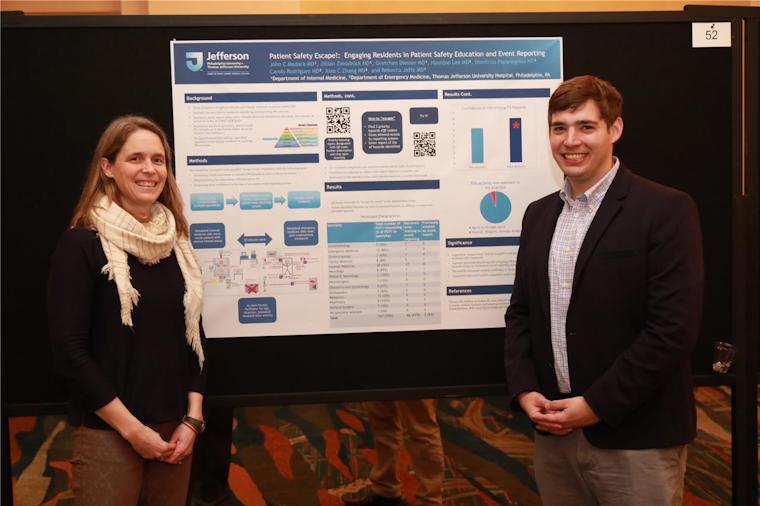John Madara, MD wanted to find a way to improve incoming residents’ ability to identify and mitigate patient safety hazards, address these hazards through teamwork and collaboration, and report safety events using an online event reporting system. Dr. Madara, the chief fellow in pulmonary and critical care medicine at Thomas Jefferson University Hospital, Willow Grove, Pennsylvania, worked with others to create an interactive, competitive “escape room” themed environment to stimulate learning and teamwork. His poster, Patient Safety Escape!: Engaging Residents in Patient Safety Education and Event Reporting, reports on the activity and its effectiveness in teaching residents about patient safety and online reporting procedures.
Primary Author: John Madara MD
Co-Authors: Jillian Zavodnick, MD; Gretchen Diemer, MD; Rebecca Jaffe, MD; from Thomas Jefferson University Hospital Department of Internal Medicine; and Hyunjoo Lee, MD; Dimitrios Papanagnou, MD, Carlos Rodriguez, MD; Xiao C. Zhang, MD; from Thomas Jefferson University Hospital Department of Emergency Medicine.
ACGME: Tell us about your academic and professional role.
Madara: I am currently in my final year of fellowship at Thomas Jefferson University Hospital. In addition to my clinical and research duties, I spend a lot of time developing educational curriculums and didactic lectures for the internal medicine house staff.
ACGME: Can you briefly describe your project for us?
Madara: Educating residents on patient safety and submitting reports of significant events have historically been a difficult topic to teach. It is difficult to keep house staff engaged in these two very important topics with all the other responsibilities that they have. We used a gamified “Escape the Room” activity to promote teamwork and spark interest in our house staff. Multiple rooms were designed and created in our simulation center, which models patient and physician interactions in the emergency department and medicine wards. Residents from multiple specialties were integrated and split into small teams, and worked together to discover patient safety-related clues in the room. When clues were discovered, it gave them a piece of the key to escape, and when all pieces were found, the team was able to submit an online event report and “escape the room.”
ACGME: What inspired you to do this project?
Madara: I approached a few of my co-authors—Drs. Jill Zavodnick, Gretchen Diemer, and Rebecca Jaffe—regarding my interest in participating in any projects to further my career in academic medicine and medical education. When they told me about their ideas to use an “Escape the Room” styled activity, I was immediately interested.
ACGME: What did you discover?
Madara: This was a great way to promote teamwork and camaraderie with new, incoming house staff at our institution. This approach was successful in increasing their comfort levels in submitting an online event report.
ACGME: What was the main takeaway?
Madara: This is a fun way to involve and engage new house staff in topics that have historically been difficult to teach.
ACGME: Who could benefit from this?
Madara: Really, we feel this is a method that can be used at multiple levels of training and aim to teach a multitude of topics. We used patient safety education and online event reporting as our focus of this activity, but we could imagine scenarios in which other topics can be focused on and taught in a new and unique way.
ACGME: Any additional follow-up plans?
Madara: It will be interesting to see if overall house staff online submissions have increased after implementing this teaching method. We also intend on creating additional “Escape the Rooms” for other historically difficult-to-teach topics.

